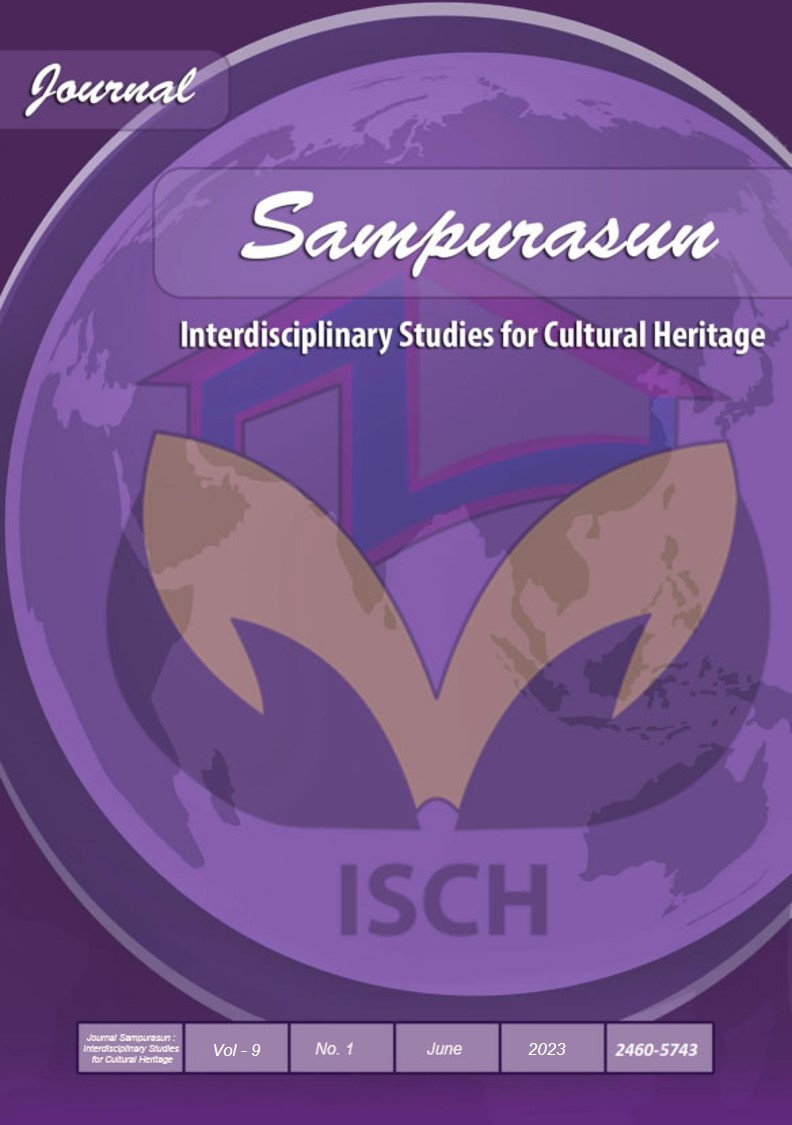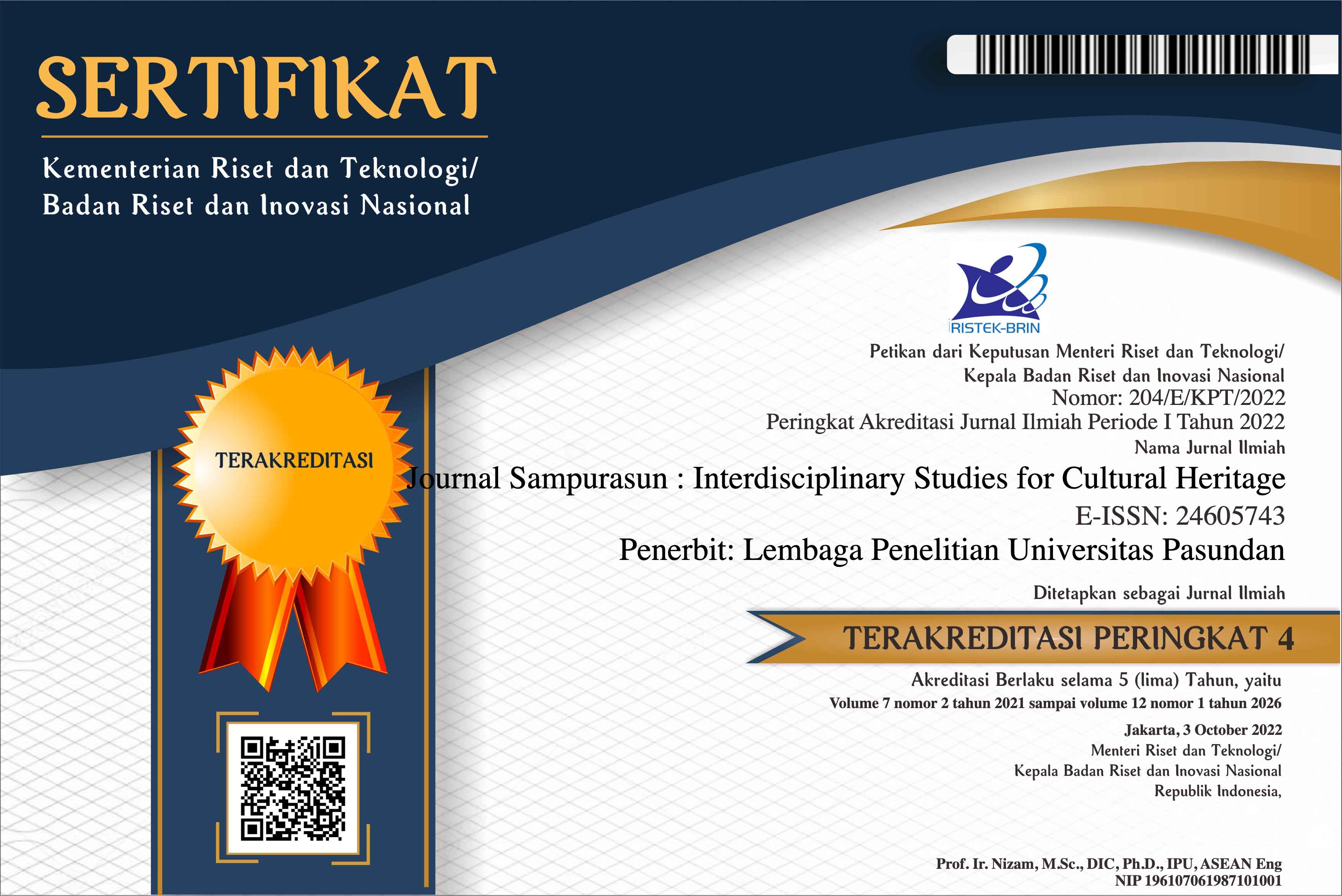SUNDANESE TRADITIONAL GAMES AS MEDIA FOR PROMOTING CHILDREN’S COGNITIVE, AFFECTIVE AND PSYCHOMOTOR DEVELOPMENT IN CIKAUM SUBANG
DOI:
https://doi.org/10.23969/sampurasun.v9i1.7301Keywords:
Sundanese traditional games, preschool age, children’s developmentAbstract
Preschool age that ranges from three to five years old is considered as a critical period for children’s development in several aspects. This development is highly suggested to be stimulated through activities that can be enjoyed by the children. Starting from this point, this study aims to investigate how Sundanese traditional games can promote the development of children’s cognitive, affective, and psychomotor abilities that are widely recognized as the three crucial learning domains proposed by Bloom (1956). The study that was conducted in Early Childhood Education (PAUD) in Cikaum Subang employed a descriptive qualitative method. The data of this study were taken from questionnaires that were distributed to 92 PAUD teachers as the participants. The study reveals that about 85% of the participants implemented traditional games as one of the teaching methods in their classes. Based on the analysis, it was found that the various types of traditional games employed by singing, guessing riddles, doing role play, and involving physical activities could promote the development of children’s cognitive, affective, and psychomotor capacities in three main ways. First, they provided children with game activities that could stimulate their thinking, counting, remembering, and solving problems capacity. Second, they helped develop children’s emotional quotient through the values learned and rules implemented in the games. Lastly, they involved physical activities that could improve the children’s strength, durability, flexibility,and balance.
Downloads
References
Anning, A., & Edwards, A. (2006). Promoting children’s learning from birth to five: Developing the new early years professional. Maidenhead: Open University Press.
DeCaprio, Richard. (2013). Aplikasi Teori Pembelajaran Motorik Di Sekolah. Yogyakarta: Diva Press.
Elkind, D. (2007). The Power of play: How spontaneous, imaginative activities lead to happier, healthier children. Cambridge, MA: Da Capo Press.
Erikson, E. H. (1950), Childhood and society, W. W. Norton & Company Inc., New York.
Fromberg, D.P,. & Bergen, D. (2006). Introduction. In D.P. Fromberg and D. Bergen (Eds) Play from birth to twelve: Contexts, perspectives and meanings. New York: Routledge.
Gülay, O., Mirzeoǧlu, D., & Çelebi, M. (2010). Effects of cooperative games on social skill levels and attitudes toward physical education. Egitim Arastirmalari - Eurasian Journal of Educational Research, 40, 77–92.
Khasanah, Ismatul., Prasetyo, Agung., Rakhmawati, Ellya. (2011). Permainan Tradisional Sebagai Media Stimulasi Aspek Perkembangan Anak Usia Dini. Jurnal Penelitian PAUDIA, Volume 1 No. 1. https://journal.upgris.ac.id/index.php/paudia/article/viewFile/261/230
Kolb, A. Y., & Kolb, D. A. (2010). Learning to play, playing to learn: A case study of a ludic learning space. Journal of Organizational Change Management, 23(1), 26-50.
Kolb, D. A. (1984). Experiential learning: Experience as the source of learning and development. New Jersey: Prentice Hall.
Mayall, B. (2002). Towards a sociology for childhood. Buckingham: Open University Press.
Milles, Matthew B., Huberman, Michael. (1994). Qualitative Data Analysis. London: Sage Publication.
Moeleong, Lexy. (2002). Metode Penelitian Kualitatif. Bandung: Remaja Rosdakarya.
Murdiyanto, Eko. (2020). METODE PENELITIAN KUALITATIF (Teori dan Aplikasi disertai Contoh Proposal). Lembaga Penelitian dan Pengabdian Pada Masyarakat UPN ”Veteran” Yogyakarta Press.
Nassaji, Hossein. (2015). Qualitative and descriptive research: Data type versus data analysis. Language Teaching Research 2015, Vol. 19(2) 129–132. https://journals.sagepub.com/doi/epub/10.1177/1362168815572747
Newman, Barbara R. and Newman, Philip R. (2020). Biosocial Theories: Biosocial genetics and sociology. Retrieved from https://www.sciencedirect.com/topics/psychology/cognitive-ability
Piaget, J. (1962). Play, dreams and imitation in childhood. New York: W. W. Norton & Company.
Pratama, Reza Resah. (2020). Traditional Games for Early Children. 1st International Conference On Education and Sports Science 2020. https://conference.binadarma.ac.id/index.php/incess/issue/current
Rusandi., Rusli, Muhammad. (2020). Merancang Penelitian Kualitatif Dasar/Deskriptif dan Studi Kasus. Journal of Education and Islamic Studies 2020, vol. 2, no. 1. https://jurnal.staiddimakassar.ac.id/index.php/aujpsi/article/download/18/18/90
Russ, S. W. (2004). Play in child development and psychotherapy: Toward empirically supported practice. Mahwah, New Jersey: Lawrence Erlbaum Associates, Inc.
Satriana, Malpaleni. (2013). PERMAINAN TRADISIONAL BERBASIS BUDAYA SUNDA SEBAGAI SARANA STIMULASI PERKEMBANGAN ANAK USIA DINI (Studi etnografi di Desa Jatitujuh Kabupaten Majalengka-Jawa Barat, Tahun 2011). JURNAL PENDIDIKAN USIA DINI Volume 7, Edisi 1 April 2013. https://media.neliti.com/media/publications/117330-ID-permainan-tradisional-berbasis-budaya-su.pdf
Smith, P. K., & Pellegrini, A. (2013). Learning through play. Encyclopedia on Early Childhood Development, June, 1-6. Retrieved February 5, 2016 from http://Www.Child-Encyclopedia.Com/Pages/Pdf/SmithPellegriniangxp2.Pdf
Sukardi. (2014). Metodologi Penelitian Pendidikan Kompetensi dan Praktiknya. Jakarta: Bumi Aksara.
Vygotsky, L. S. (1966). Play and its role in the mental development of the child. Voprosy Psikhologii, 12, 62-76.
Vygotsky, L. S. (1997). Thought and language. Massachusetts: The MIT Press.
Downloads
Published
Issue
Section
License
Copyright (c) 2023 Journal Sampurasun : Interdisciplinary Studies for Cultural Heritage

This work is licensed under a Creative Commons Attribution 4.0 International License.
Copyright Notice
Authors should not withdraw their submitted papers because the withdrawal wastes voluntary works devoted by an associate editor and reviewers. But, we accept the withdrawal of a submitted paper if authors have unavoidable reasons. In the event that a manuscript is to be withdrawn from submission to Sampurasun Journal, a letter must be sent to the editorial office requesting withdrawal by e-mail (sampurasunjournal@unpas.ac.id) with its scanned PDF file, before the notification of acceptance for publication.
The withdraw request letter must include the following information. Paper ID, Paper title, Authors names, Reason why the paper must be withdrawn, and Date and signatures of all the authors (or signature of the contact author).
If only the contact author signs the letter, he/she must obtain the agreement of the withdrawal from all the other authors and the letter must include the description that all the other authors agreed the withdrawal. The journal will not withdraw a manuscript from peer review until such a letter has been received. Authors must not assume their manuscript has been withdrawn until they have received appropriate notification from the editorial office. Withdrawal of a manuscript subsequent to acceptance for publication will only be granted in the most exceptional of circumstances.
After the paper is accepted for publication, the withdrawal is not permitted in principle. The authors must always pay the charge even if the withdrawal is permitted. Any request of withdrawal that does not follow the above procedure is treated as invalid. If illegal submission, e.g., plagiarized or duplicate submission, is found for a paper, the withdrawal of the paper will never be permitted and the authors will be punished based on the rule. It is not acceptable practice to withdraw a manuscript in the event of acceptance at another journal. This constitutes dual submission. The editorial office of the other journal will be notified of your actions. In such circumstances Sampurasun ISCH may chose to impose appropriate punitive action subject.
Withdrawal Penalty
Author is not allowed to withdraw submitted manuscripts, because the withdrawal is waste of valuable resources that editors and referees spent a great deal of time processing submitted manuscript, money and works invested by the publisher. If author still requests withdrawal of his/her manuscript when the manuscript is still in the peer-reviewing process, author will be punished with paying $200 per manuscript, as withdrawal penalty to the publisher. However, it is unethical to withdraw a submitted manuscript from one journal if accepted by another journal. The withdrawal of manuscript after the manuscript is accepted for publication, author will be punished by paying US$500 per manuscript. Withdrawal of manuscript is only allowed after withdrawal penalty has been fully paid to the Publisher. If author don't agree to pay the penalty, the author and his/her affiliation will be blacklisted for publication in this journal. Even, his/her previously published articles will be removed from our online system.


















